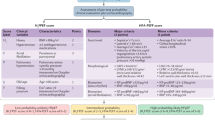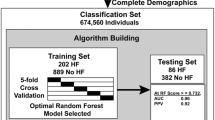Abstract
Heart failure with preserved ejection fraction (HFpEF) is a common disorder with few effective treatments, and there is currently no evidence-based method to identify preclinical HFpEF. The H2FPEF score is a validated instrument to identify patients with overt HFpEF. Here we show that the H2FPEF score can identify individuals with preclinical HFpEF. Among individuals where heart failure was excluded (n = 160), increasing H2FPEF score was shown to be associated with greater left atrial dilation, left ventricular hypertrophy and more severe diastolic dysfunction. Patients with increasing H2FPEF score displayed higher pulmonary artery pressures, higher left heart filling pressures, lower cardiac index and more severely impaired aerobic capacity during exercise. In summary, we show that, among adults without heart failure, higher H2FPEF score is associated with subclinical abnormalities that resemble those observed in HFpEF. These findings broaden the external validity of the H2FPEF score and suggest that this instrument might help identify patients positioned to benefit from preventive interventions.
This is a preview of subscription content, access via your institution
Access options
Subscribe to this journal
Receive 12 digital issues and online access to articles
$119.00 per year
only $9.92 per issue
Buy this article
- Purchase on Springer Link
- Instant access to full article PDF
Prices may be subject to local taxes which are calculated during checkout



Similar content being viewed by others
Data availability
De-identified participant data will be made available upon reasonable request. Requests should be directed to the corresponding author (B.A.B.). Requestors will be required to sign a data access agreement to ensure the appropriate use of the study data.
References
Pfeffer, M. A., Shah, A. M. & Borlaug, B. A. Heart failure with preserved ejection fraction in perspective. Circ. Res. 124, 1598–1617 (2019).
Shah, S. J. et al. Research priorities for heart failure with preserved ejection fraction: National Heart, Lung, and Blood Institute working group summary. Circulation 141, 1001–1026 (2020).
Borlaug, B. A. Evaluation and management of heart failure with preserved ejection fraction. Nat. Rev. Cardiol. 17, 559–573 (2020).
Upadhya, B. et al. Effect of intensive blood pressure treatment on heart failure events in the Systolic Blood Pressure Reduction Intervention Trial. Circ. Heart Fail. 10, e003613 (2017).
Kostis, J. B. et al. Prevention of heart failure by antihypertensive drug treatment in older persons with isolated systolic hypertension. SHEP Cooperative Research Group. JAMA 278, 212–216 (1997).
Beckett, N. S. et al. Treatment of hypertension in patients 80 years of age or older. N. Engl. J. Med. 358, 1887–1898 (2008).
Group, S. R. et al. A randomized trial of intensive versus standard blood-pressure control. N. Engl. J. Med. 373, 2103–2116 (2015).
Davis, B. R. et al. Heart failure with preserved and reduced left ventricular ejection fraction in the antihypertensive and lipid-lowering treatment to prevent heart attack trial. Circulation 118, 2259–2267 (2008).
Sundstrom, J. et al. Weight loss and heart failure: a nationwide study of gastric bypass surgery versus intensive lifestyle treatment. Circulation 135, 1577–1585 (2017).
Rayner, J. J. et al. Myocardial energetics in obesity: enhanced ATP delivery through creatine kinase with blunted stress response. Circulation 141, 1152–1163 (2020).
Reddy, Y. N. V. et al. Hemodynamic effects of weight loss in obesity: a systematic review and meta-analysis. JACC Heart Fail. 7, 678–687 (2019).
Aminian, A. et al. Association of metabolic surgery with major adverse cardiovascular outcomes in patients with type 2 diabetes and obesity. JAMA 322, 1271–1282 (2019).
Abed, H. S. et al. Effect of weight reduction and cardiometabolic risk factor management on symptom burden and severity in patients with atrial fibrillation: a randomized clinical trial. JAMA 310, 2050–2060 (2013).
Djousse, L., Driver, J. A. & Gaziano, J. M. Relation between modifiable lifestyle factors and lifetime risk of heart failure. JAMA 302, 394–400 (2009).
Howden, E. J. et al. Reversing the cardiac effects of sedentary aging in middle age—a randomized controlled trial: implications for heart failure prevention. Circulation 137, 1549–1560 (2018).
Bhella, P. S. et al. Impact of lifelong exercise ‘dose’ on left ventricular compliance and distensibility. J. Am. Coll. Cardiol. 64, 1257–1266 (2014).
Borlaug, B. A., Kane, G. C., Melenovsky, V. & Olson, T. P. Abnormal right ventricular-pulmonary artery coupling with exercise in heart failure with preserved ejection fraction. Eur. Heart J. 37, 3293–3302 (2016).
Borlaug, B. A. et al. Global cardiovascular reserve dysfunction in heart failure with preserved ejection fraction. J. Am. Coll. Cardiol. 56, 845–854 (2010).
Reddy, Y. N. V., Olson, T. P., Obokata, M., Melenovsky, V. & Borlaug, B. A. Hemodynamic correlates and diagnostic role of cardiopulmonary exercise testing in heart failure with preserved ejection fraction. JACC Heart Fail. 6, 665–675 (2018).
Reddy, Y. N. V., Carter, R. E., Obokata, M., Redfield, M. M. & Borlaug, B. A. A simple, evidence-based approach to help guide diagnosis of heart failure with preserved ejection fraction. Circulation 138, 861–870 (2018).
Hunt, S. A. et al. ACC/AHA 2005 guideline update for the diagnosis and management of chronic heart failure in the adult: a report of the American College of Cardiology/American Heart Association Task Force on Practice Guidelines (Writing Committee to Update the 2001 Guidelines for the Evaluation and Management of Heart Failure). J. Am. Coll. Cardiol. 46, e1–e82 (2005).
Shah, A. M. et al. Heart failure stages among older adults in the community: the atherosclerosis risk in communities study. Circulation 135, 224–240 (2017).
Selvaraj, S. et al. Application of diagnostic algorithms for heart failure with preserved ejection fraction to the community. JACC Heart Fail. 8, 640–653 (2020).
Nagueh, S. F. Diagnostic algorithms for heart failure with preserved ejection fraction. JACC Heart Fail. 8, 654–656 (2020).
Reddy, Y. N. V., Obokata, M., Verbrugge, F. H., Lin, G. & Borlaug, B. A. Atrial dysfunction in patients with heart failure with preserved ejection fraction and atrial fibrillation. J. Am. Coll. Cardiol. 76, 1051–1064 (2020).
Obokata, M., Reddy, Y. N., Pislaru, S. V., Melenovsky, V. & Borlaug, B. A. Evidence supporting the existence of a distinct obese phenotype of heart failure with preserved ejection fraction. Circulation 136, 6–19 (2017).
Reddy, Y. N. V., Obokata, M., Gersh, B. J. & Borlaug, B. A. High prevalence of occult heart failure with preserved ejection fraction among patients with atrial fibrillation and dyspnea. Circulation 137, 534–535 (2018).
Hieda, M. et al. One-year committed exercise training reverses abnormal left ventricular myocardial stiffness in patients with stage B heart failure with preserved ejection fraction. Circulation 144, 934–946 (2021).
Sugumar, H. et al. A prospective STudy using invAsive haemodynamic measurements foLLowing catheter ablation for AF and early HFpEF: STALL AF-HFpEF. Eur. J. Heart Fail. 23, 785–796 (2021).
Zinman, B. et al. Empagliflozin, cardiovascular outcomes, and mortality in type 2 diabetes. N. Engl. J. Med. 373, 2117–2128 (2015).
Pieske, B. et al. How to diagnose heart failure with preserved ejection fraction: the HFA-PEFF diagnostic algorithm: a consensus recommendation from the Heart Failure Association (HFA) of the European Society of Cardiology (ESC). Eur. Heart J. 40, 3297–3317 (2019).
Nagueh, S. F. et al. Recommendations for the evaluation of left ventricular diastolic function by echocardiography: an update from the American Society of Echocardiography and the European Association of Cardiovascular Imaging. J Am Soc Echocardiogr. 29, 277–314 (2016).
Obokata, M. et al. Role of diastolic stress testing in the evaluation for heart failure with preserved ejection fraction: a simultaneous invasive-echocardiographic study. Circulation 135, 825–838 (2017).
Reddy, Y. N. V. et al. Arterial stiffening with exercise in patients with heart failure and preserved ejection fraction. J. Am. Coll. Cardiol. 70, 136–148 (2017).
Acknowledgements
K.E.K. was supported by F31 HL143952, and B.A.B. is supported by R01 HL128526, both from the National Institutes of Health.
Author information
Authors and Affiliations
Contributions
Study conception and design: K.E.K. and B.A.B.; Project supervision: B.A.B.; Data acquisition: K.E.K., Y.N.V.R., M.O., H.S., F.H.V., C.C.J., A.C.E., M.M.R., T.P.O. and B.A.B.; Data analysis: K.E.K., Y.N.V.R. and B.A.B.; Manuscript drafting: K.E.K., Y.N.V.R. and B.A.B.; Manuscript critical revision: K.E.K., Y.N.V.R., M.O., H.S., F.H.V., C.C.J., A.C.E., M.M.R., T.P.O. and B.A.B.
Corresponding author
Ethics declarations
Competing interests
The authors declare no competing interests.
Peer review information
Nature Cardiovascular Research thanks Rudolf de Boer and Domenico Bruno for their contribution to the peer review of this work.
Additional information
Publisher’s note Springer Nature remains neutral with regard to jurisdictional claims in published maps and institutional affiliations.
Supplementary information
Supplementary Information
This file contains Supplemental/Extended Data Tables 1–7
Rights and permissions
About this article
Cite this article
Koepp, K.E., Reddy, Y.N.V., Obokata, M. et al. Identification of patients with preclinical heart failure with preserved ejection fraction using the H2FPEF score. Nat Cardiovasc Res 1, 59–66 (2022). https://doi.org/10.1038/s44161-021-00005-5
Received:
Accepted:
Published:
Issue Date:
DOI: https://doi.org/10.1038/s44161-021-00005-5



